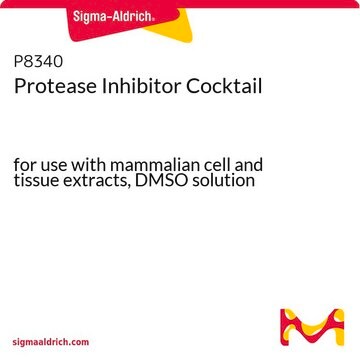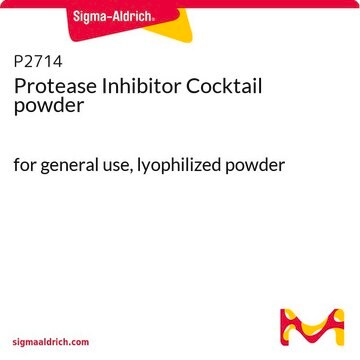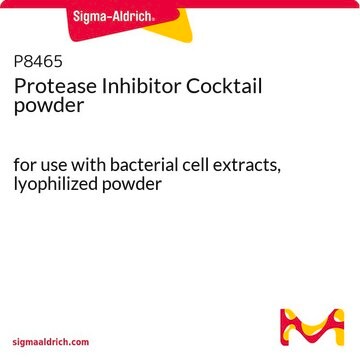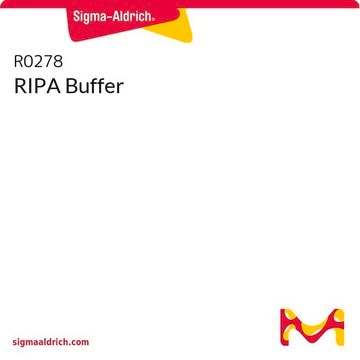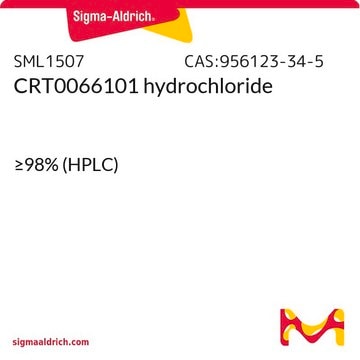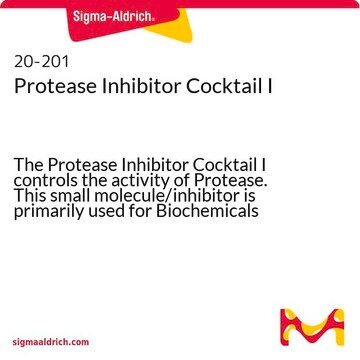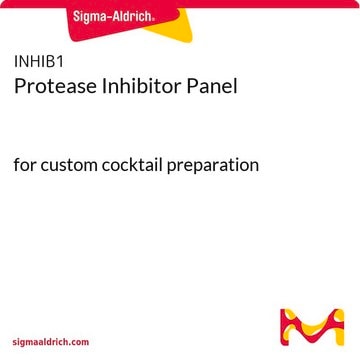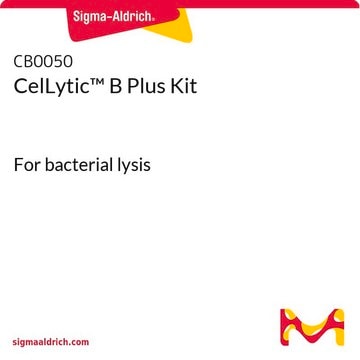While not specifically listed as a '100X' concentration, a volume of 1 ml of this solution is sufficient for 100ml of cell lysate. However, this is based on the mass and origin of the lysate preparation. The 100 mL of cell lysate referenced is prepared from 20 g of E. coli cells or 10 g of baculovirus-infected cells. Please see the link below to review additional information available in the product datasheet:
https://www.sigmaaldrich.com/deepweb/assets/sigmaaldrich/product/documents/934/419/p8849dat-ms.pdf
P8849
Protease Inhibitor Cocktail
DMSO solution, for the inhibition of serine, cysteine, aspartic, aminopeptidases and thermolysin-like activities, for use in purification of Histidine-tagged proteins, DMSO solution
Sinónimos:
Protease inhibitor solution
About This Item
Productos recomendados
Nombre del producto
Cóctel de inhibidores de proteasas, for use in purification of Histidine-tagged proteins, DMSO solution
biological source
synthetic
Quality Level
form
DMSO solution
storage temp.
−20°C
¿Está buscando productos similares? Visita Guía de comparación de productos
General description
The cocktail contains a mixture of inhibitors that specifically target serine, cysteine, aspartic, and thermolysin-like proteases, and aminopeptidases.
Specificity
Application
It is recommended for inhibition of protease activity in 100 mL of cell lysate from 20 g of Escherichia coli or 10 g of baculovirus-infected Spodoptera frugiperda pupal ovary cells.
Features and Benefits
Targets multiple types of proteases, ensuring comprehensive inhibition of protease activity.
Compatibility with IMAC applications due to omission of chelating agents.
Supplied in convenient packaging options.
Components
Bestatin
E-64
Pepstatin A
Phosphoramidon
Quantity
This protease inhibitor cocktail has been optimized and tested for histidine-tagged proteins
Preparation Note
related product
Storage Class
10 - Combustible liquids
wgk_germany
WGK 1
flash_point_f
185.0 °F - closed cup
flash_point_c
85 °C - closed cup
Elija entre una de las versiones más recientes:
Certificados de análisis (COA)
¿No ve la versión correcta?
Si necesita una versión concreta, puede buscar un certificado específico por el número de lote.
¿Ya tiene este producto?
Encuentre la documentación para los productos que ha comprado recientemente en la Biblioteca de documentos.
Los clientes también vieron
Contenido relacionado
Select different protease inhibitor types based on your needs to prevent protein degradation during isolation and characterization and safeguard proteins in sample prep.
-
Is it 100x?
1 answer-
Helpful?
-
-
What is the stability at -20°C of the protease inhibitor cocktail in DMSO?
1 answer-
This product is quite stable when stored at the recommended -20°C. The material is not assigned an expiration date but has a recommended retest date of 4 years from the date of quality release.
Helpful?
-
-
Is there any miscibility data available for Cat # P8849?
1 answer-
P8849 is DMSO based, and DMSO is known to be miscible in water and cell culture media. The product is supplied as a clear solution in DMSO, with 1 mL of solution.
Helpful?
-
-
Can this product be used in Expi293 mammalian cell culture for stability of secreted proteins without harming the cells during expression or is this recommended only after cells spun out of media containing 6-His tagged proteins?
1 answer-
This product has not been tested for use in cell culture medium as an additive to preserve secreted proteins. Please see the link below to review an alternative product tested specifically for this application:
P1860 Datasheet
https://www.sigmaaldrich.com/deepweb/assets/sigmaaldrich/product/documents/413/261/p1860dat-ms.pdfP1860 Product Page
https://www.sigmaaldrich.com/product/sigma/p8340Helpful?
-
-
What is the difference between Protease Inhibitors P8849 and S8830?
1 answer-
P8849 is a DMSO solution and S8830 is a water soluble tablet. P8849 formulation is considered proprietary but does contain AEBSF, Pepstatin A, Bestatin, E-64, and Phosphoramidon. The formulation of S8830 also contains Aprotinin and Pepstatin A and the exact formulation is given on the product information sheet (under Documents, above).
Helpful?
-
-
Can Product No. P8849, Protease Inhibitor Cocktail, be used with with HIS-Select™ products or any other immobilized metal affinity chromatography (IMAC) products?
1 answer-
This product does not contain EDTA and can be used with sample processing by immobilized metal affinity chromatography (IMAC) suchas used for the purification of histidine-tagged proteins..
Helpful?
-
-
How much of Product No. P8849, Protease Inhibitor Cocktail, should be added to the cell lysate?
1 answer-
A 1:100 dilution is the recommended concentration.
Helpful?
-
-
What is the Department of Transportation shipping information for this product?
1 answer-
Transportation information can be found in Section 14 of the product's (M)SDS.To access the shipping information for this material, use the link on the product detail page for the product.
Helpful?
-
Active Filters
Nuestro equipo de científicos tiene experiencia en todas las áreas de investigación: Ciencias de la vida, Ciencia de los materiales, Síntesis química, Cromatografía, Analítica y muchas otras.
Póngase en contacto con el Servicio técnico